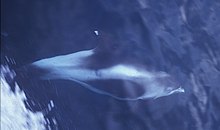White-beaked dolphin
| White-beaked dolphin | |
|---|---|

| |

| |
| Size compared to an average human | |
| Scientific classification | |
| Domain: | Eukaryota |
| Kingdom: | Animalia |
| Phylum: | Chordata |
| Class: | Mammalia |
| Order: | Artiodactyla |
| Infraorder: | Cetacea |
| Family: | Delphinidae |
| Genus: | Lagenorhynchus |
| Species: | L. albirostris
|
| Binomial name | |
| Lagenorhynchus albirostris (Gray, 1846)
| |

| |
| White-beaked dolphin range | |
The white-beaked dolphin (Lagenorhynchus albirostris) is a
Taxonomy
The species was first described by the British taxonomist John Edward Gray in 1846. Due to its relative abundance in European waters, it was among the first of the genus Lagenorhynchus (lagenos, Latin for "bottle" or "flask"; rhynchos, "beak" or "snout") to be known to science. Its specific name, albirostris, translates to "white beak", a reference to the color of the species' beak, a diagnostic (albeit variable) trait useful in identification.[3]
Description

The white-beaked dolphin is a robust species of dolphin with a short beak. Adults can reach 2.3 to 3.1 m (7 ft 7 in to 10 ft 2 in) long and weigh 180 to 354 kg (397 to 780 lb). Calves are 1.1 to 1.2 m (3 ft 7 in to 3 ft 11 in) long at birth and probably weigh about 40 kg (88 lb).[4] The upper body and flanks are dark grey with light grey patches, including a 'saddle' behind the dorsal fin, while the underside is light grey to almost white in color. The flippers, fluke, and the tall, falcate, dorsal fin are all a darker grey than the body. As the common name implies, the beak is usually white in color, but it may be a dark, ashy grey, in some older individuals.[5]
White-beaked dolphins have 25 to 28 teeth in each jaw, although the three teeth closest to the front of the mouth are often not visible, failing to erupt from the gums. They have up to 92
Distribution and habitat

The white-beaked dolphin is
The dolphin may easily be misidentified as the Atlantic white-sided dolphin, although the white-beaked is commonly found further north. The white-beaked dolphin is also typically larger, and does not have yellow streaks on its side.
Biology and behavior

The population, breeding pattern, and life expectancy of the dolphin are all unknown, although most sources estimate several hundred thousand individuals, more densely populated in the eastern North Atlantic than the west.
White-beaked dolphins feed predominantly on
White-beaked dolphins are acrobatic; they will frequently ride on the
Mating probably takes place in the summer,[17] with calves being born in the following year, between June and September.[13] Females reach their adult size at around five years of age, and are sexually mature at six to ten years, while males reach adult size at around ten years, and reach sexual maturity about two years later than females.[6]
Conservation
The North and Baltic Sea populations of the white-beaked dolphin are listed on Appendix II
In addition, the white-beaked dolphin is covered by the Agreement on the Conservation of Small Cetaceans of the Baltic, North East Atlantic, Irish and North Seas (
See also
References
- . Retrieved 19 November 2021.
- ^ "Appendices | CITES". cites.org. Retrieved 14 January 2022.
- ISBN 0-375-41141-0.
- ISBN 9780691127569.
- .
- ^ .
- .
- S2CID 84752148.
- ^ Polar bears eating dolhins as waters warm Bloomberg News, retrieved June 12, 2015
- .
- ^ Van Bressem, Marie-Françoise; Burville, Ben; Sharpe, Matt; Berggren, Per; Van Waerebeek, Koen (23 March 2018). "Visual health assessment of white-beaked dolphins off the coast of Northumberland, North Sea, using underwater photography". Wiley Online Library. Marine Mammal Science. Retrieved 26 March 2021.
- S2CID 55878106.
- ^ S2CID 85215744.
- S2CID 86542432.
- ^ Rasmussen, M.H. & Miller, L.A. (2002). "Whistles and clicks from white-beaked dolphins, Lagenorhynchus albirostris, recorded in Faxaflói Bay, Iceland" (PDF). Aquatic Mammals. 28 (1): 78–89.
- PMID 16875247.
- .
- ^ "Appendix II Archived 11 June 2011 at the Wayback Machine" of the Convention on the Conservation of Migratory Species of Wild Animals (CMS). As amended by the Conference of the Parties in 1985, 1988, 1991, 1994, 1997, 1999, 2002, 2005 and 2008. Effective: 5 March 2009.
- ^ Convention on Migratory Species page on the White-beaked dolphin
- ^ Agreement on the Conservation of Small Cetaceans of the Baltic, North East Atlantic, Irish and North Seas
- Whales Dolphins and Porpoises, Mark Carwardine, Dorling Kindersley Handbooks, ISBN 0-7513-2781-6
- National Audubon Society Guide to Marine Mammals of the World, Reeves, Stewart, Clapham and Powell, ISBN 0-375-41141-0
External links
- White-beaked dolphin research in Scotland White-beaked dolphins in Scottish waters, images
- ARKive Photos, video, information.

